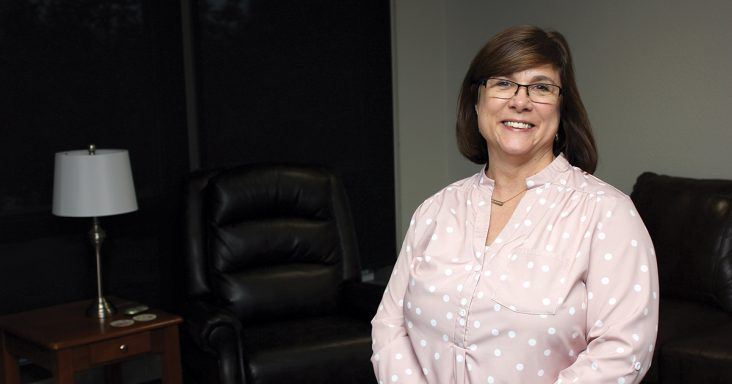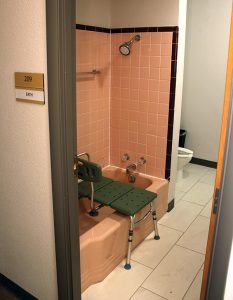UA, UAMS start occupational therapy clinical program
by November 19, 2019 2:56 pm 1,415 views

Sherry Muir is the founding program director of the Doctor of Occupational Therapy Program. She has spent the past two years developing the joint program between the University of Arkansas and the University of Arkansas for Medical Sciences.
The University of Arkansas and the University of Arkansas for Medical Sciences (UAMS) will soon welcome the initial cohort of students in a new occupational therapy program, which is the first joint clinical program between the two universities.
Classes for the three-year, full-time program begin Jan. 2 and will run throughout the year. The first cohort of 32 students is expected to graduate in December 2022 and will receive a clinical doctorate in occupational therapy. The program has been in the works since 2014 and received approval in 2016 from the Arkansas Division of Higher Education.
The 115 credit-hour program has a capacity of 32 students per year, or up to 96 students by its third year. About 50 people applied for the first year of the program.
Sherry Muir, founding program director of the Doctor of Occupational Therapy Program, expects the number of applicants to rise to more than 500 when the program reaches full accreditation.
In July, the program received candidacy status from the Accreditation Council for Occupational Therapy Education of the American Occupational Therapy Association. The status allows the program to start accepting students. Full accreditation will allow graduates of the program to take the exam to become registered occupational therapists.
Occupational therapists help people “to do the things they want and need to do through the therapeutic use of daily activities,” or occupations, according to the association. In Arkansas, 1,210 people work in the profession and earn an average salary of $81,810 annually, according to the Bureau of Labor Statistics. Nationwide, 126,900 people are occupational therapists and receive an average wage of $85,350 per year.
Muir expects the new program to receive full accreditation after completing a self-study over its first two years. The association will review the program after it receives the self-study report, which should be submitted in 2021.
Students in the program will take classes at the UA and UAMS Northwest Regional Campus in Fayetteville. Three converted student apartments have become a home for prospective occupational therapists to learn about the healthcare field. The two-level home at 50 Harmon Ave. also provides for staff offices for those in the program.
Renovations to the home were completed in April. It includes a kitchen, dining room, living room, bedrooms and bathrooms to simulate the homes of patients, who often receive treatment at home. The home will complement the 7,000-square-foot facility at UAMS Northwest that will include two apartments, a gym and a garage. Some of the furniture and equipment were being installed recently.

Those who would like to enroll in the program must have a bachelor’s degree and have completed the following classes with at least a C grade: human anatomy, human physiology, statistics, terminology for health professions, abnormal psychology and neuroscience of behavior.
JOINT CLINICAL PROGRAM
The new occupational therapy program is the first UAMS Northwest clinical program with the UA and the first joint program between the universities that’s based in Northwest Arkansas, said Pearl McElfish, vice chancellor of UAMS Northwest.
“It’s an incredibly significant program, partly because it’s our first joint program with the University of Arkansas at Fayetteville in Northwest Arkansas,” McElfish said. “We really expect to have more joint programs … It’s really important that we collaborate together and are the best fiduciaries of Arkansas resources. For us, that means having joint clinical programs where UAMS can provide much of the clinical expertise and space, and we can also leverage the basic science resources and the humanities resources at the University of Arkansas.
“It’s also important that the two universities work together because ultimately our ability to work together and our ability to research together, joint programs together is going to help the overall growth of research and important programs in Northwest Arkansas, which has that economic impact.”
Both McElfish and Susan Long, dean of the College of Health Professions for UAMS, were excited about the new curriculum in the occupational therapy program and how it will prepare students to provide the best possible care to patients.
“What excites me the most about this program is the extraordinary educational experience that students will be provided in a program supported by the resources of a research-intensive institution and the state’s premier academic health science center,” Long said. “The state-of-the-art facilities, innovative curriculum and accomplished faculty are poised to help us reach our goal of being a nationally recognized premier program while meeting the workforce needs within the region, state and nation.”
McElfish also discussed Muir’s ability to start new programs. “When you’re developing new programs, you really have to have a program director that has a fire in her belly and is able to be creative and innovative in the development of a new program to make it stand out for the top students above other more established programs,” McElfish said. “And Dr. Muir definitely has that.”
FEELS LIKE HOME
Muir also is one of five faculty in the program, which has openings for two positions.
She started in her role in September 2017 and is jointly employed by the UA and UAMS. A Branson, Mo., native, Muir said the area feels like home. A search committee hired her to help start the program after a needs assessment was completed showing the need for the program here. The need was determined in the assessment for UAMS’ physical therapy program. The assessment in 2014 showed a great need for an occupational therapy program.
Before joining the UA, Muir was a full-time faculty member at St. Louis University for 13 years. She has worked as an occupational therapist for more than 27 years and received a Master of Occupational Therapy from Texas Woman’s University and a doctorate in public policy and administration from Walden University. Muir is considered the founder of primary care in occupational therapy, and this regards occupational therapists working alongside of physicians to meet a patient’s healthcare needs.
“I came here to design a program to gather around me people who believed that OT can and should be doing more,” Muir said. “We’re trying to create a program that educates occupational therapists that have the skills, and the ability and the willingness to push boundaries, to push our way into areas where clients need us — where we can make a difference and not be limited because insurance says, ‘I’m only paying for this.’”
